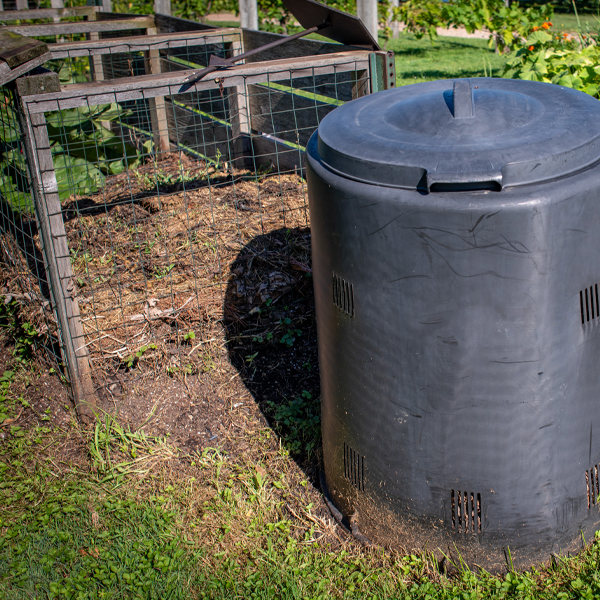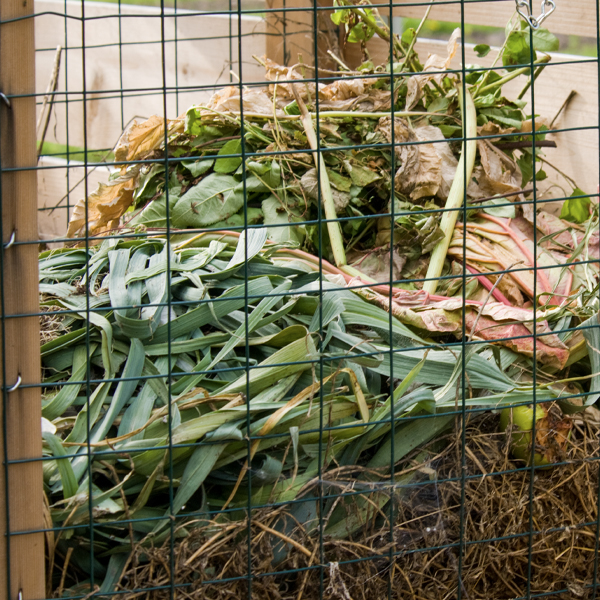An elegant earth-to-earth closed system
What smells like earth, enriches the soil, and is free for the making? Compost! A healthy compost pile is easy to maintain, has no offensive odor, and does not attract animals. Best of all, composting provides an elegant earth-to-earth closed system. Nutrient-rich scraps from vegetables grown in your garden are diverted from the landfill, instead going into the compost bin. Within a few months, they return to your garden to help the next generation of vegetables to grow.
Tips for Successful Composting
- Composting relies on heat, water, air, and the mixture of "greens" (fresh grass clippings, spent flowers, fruit and veggie scraps) and "browns" (hay, dried leaves, pine needles, etc.).
- As composting becomes more popular, more and more models are available for purchase. The simplest systems are just as effective as the more high-tech versions—in fact, a simple compost pile works fine or you can easily make a bin yourself.
- Situate your compost bin or pile in a shady outdoor area with access to rain/snow. Some sunlight is fine, but the pile should not be in constant, direct sun. For ease of access, consider placing the bin near your garden, or use a wheelbarrow to transport it from bin to garden.
- Start your pile with a four-inch layer of leaves or yard trimmings (break into small pieces to expedite the process). Add a bit of water to make the pile moist, but not soggy. Let the pile sit for a week or so.
- Begin adding food scraps. What can go into the pile? Any fruit or vegetable scraps, eggshells (smash up a bit since they take longer to break down), coffee grounds, tea bags, shredded black and white newspaper—even vacuum cleaner lint! But, do not add animal products (meat, dairy, gravy, bones, mayo, etc.) or oils/grease. These products are more likely to attract animals and to add an unpleasant odor to your compost pile.
- You'll be more likely to compost on a regular basis with a countertop container in the kitchen. Many small types and colors can now be purchased, but a coffee can does nicely, too. Get in the habit of taking out the compost when you take out the garbage.
- Every few weeks, completely mix the material in the compost bin/pile with a pitchfork, hoe, or sturdy rake. In addition to blending the "greens" and "browns," mixing helps to aerate the pile and distribute moisture evenly. You may notice an entire ecosystem thriving in your bin—insects, worms, and more! They are working to turn your scraps into rich compost.
- You may also notice that the pile is warm or even hot. Again, this is a normal—in fact, essential—part of the decomposition process. The best (thermophilic) temperature range for compost is between 135 and 160 degrees Fahrenheit. Temperatures of at least 150 degrees F. will kill eggs of undesirable parasites, cysts, and flies, as well as weed seeds. It's not a good idea to have temperatures above 160 degrees F., however, as this might hinder decomposition. (Yes, there are compost thermometers!)
- Feel free to add more yard trimmings and food scraps whenever you have them.
In about six months, your compost will look like soil (if not the whole bin, then certainly the lowest levels of the pile) and it can be used to supplement your garden. If you want to wait until planting season, your compost can keep "cooking" until you are ready to use it; just keep adding yard and food scraps.




